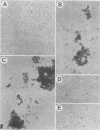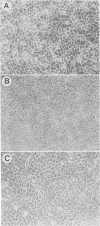Abstract
A peptide corresponding to the amino-terminal 25 amino acids of the mature vesicular stomatitis virus glycoprotein has recently been shown to be a pH-dependent hemolysin. In the present study, we analyzed smaller constituent peptides and found that the hemolytic domain resides within the six amino-terminal amino acids. Synthesis of variant peptides indicates that the amino-terminal lysine can be replaced by another positively charged amino acid (arginine) but that substitution with glutamic acid results in the total loss of the hemolytic function. Peptide-induced hemolysis was dependent upon buffer conditions and was inhibited when isotonicity was maintained with mannitol, sucrose, or raffinose. In sucrose, all hemolytic peptides were also observed to mediate hemagglutination. The large 25-amino acid peptide is also a pH-dependent cytotoxin for mammalian cells and appears to effect gross changes in cell permeability. Conservation of the amino terminus of vesicular stomatitis virus and rabies virus suggests that the membrane-destabilizing properties of this domain may be important for glycoprotein function.
Full text
PDF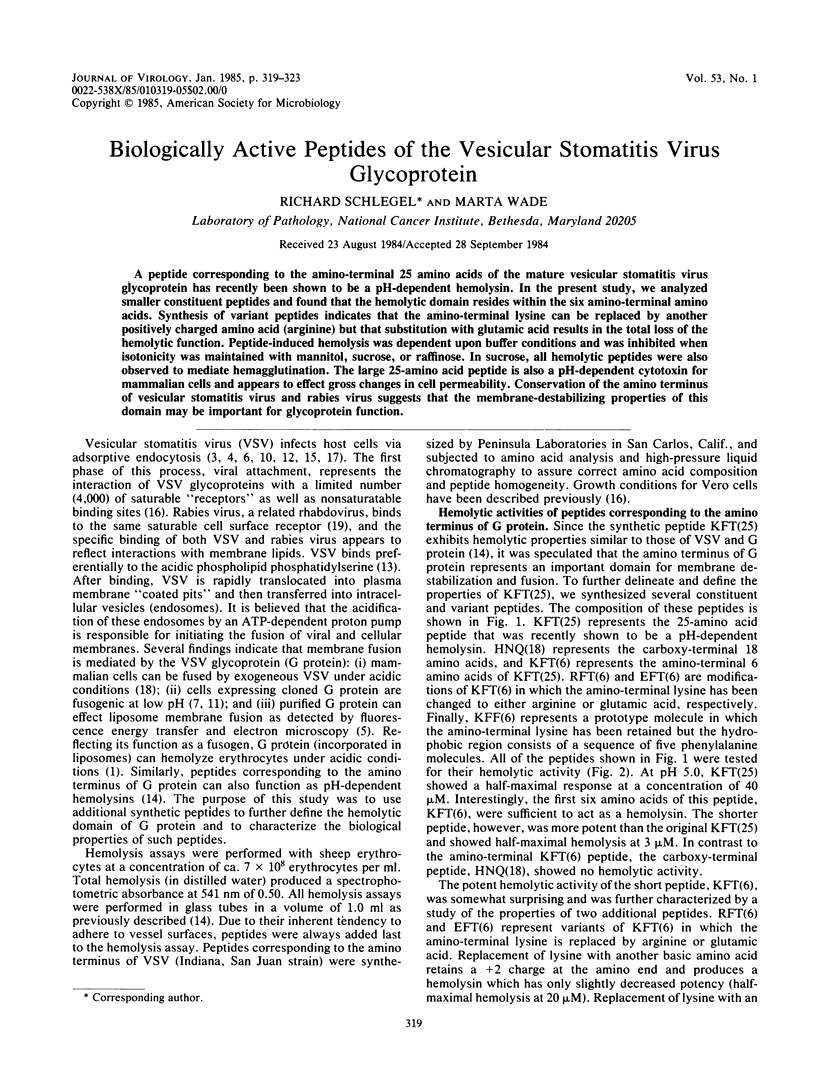
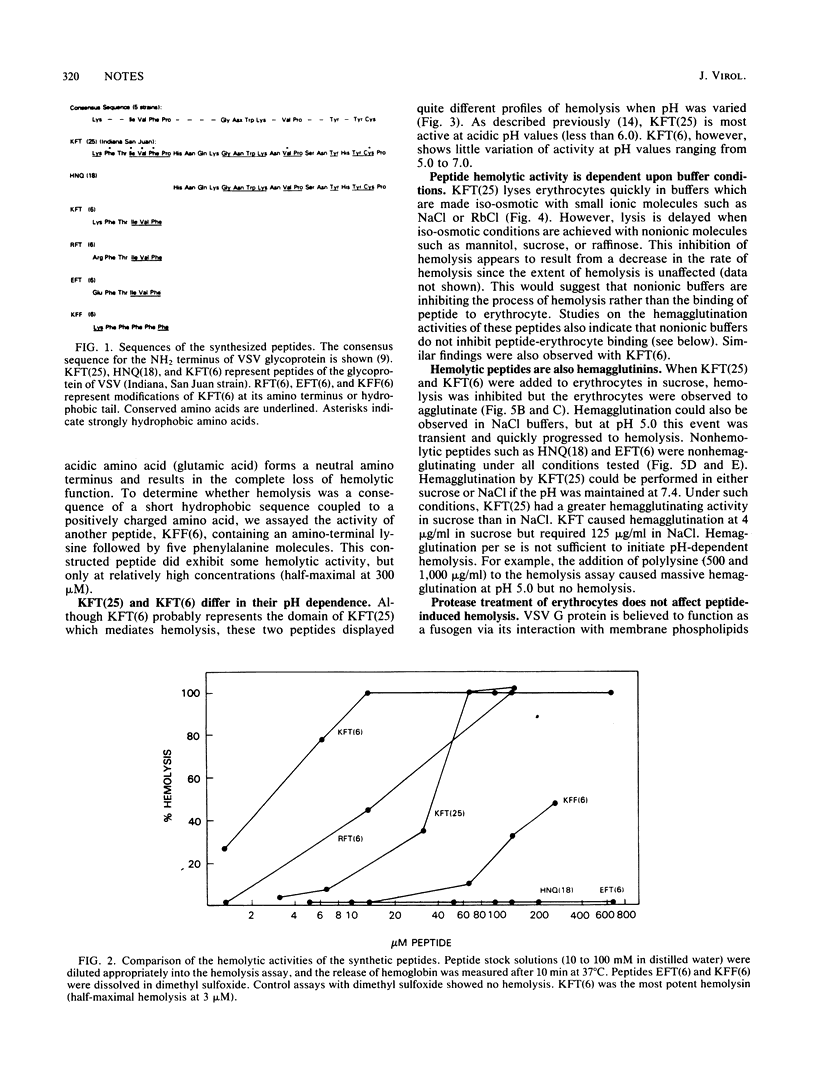
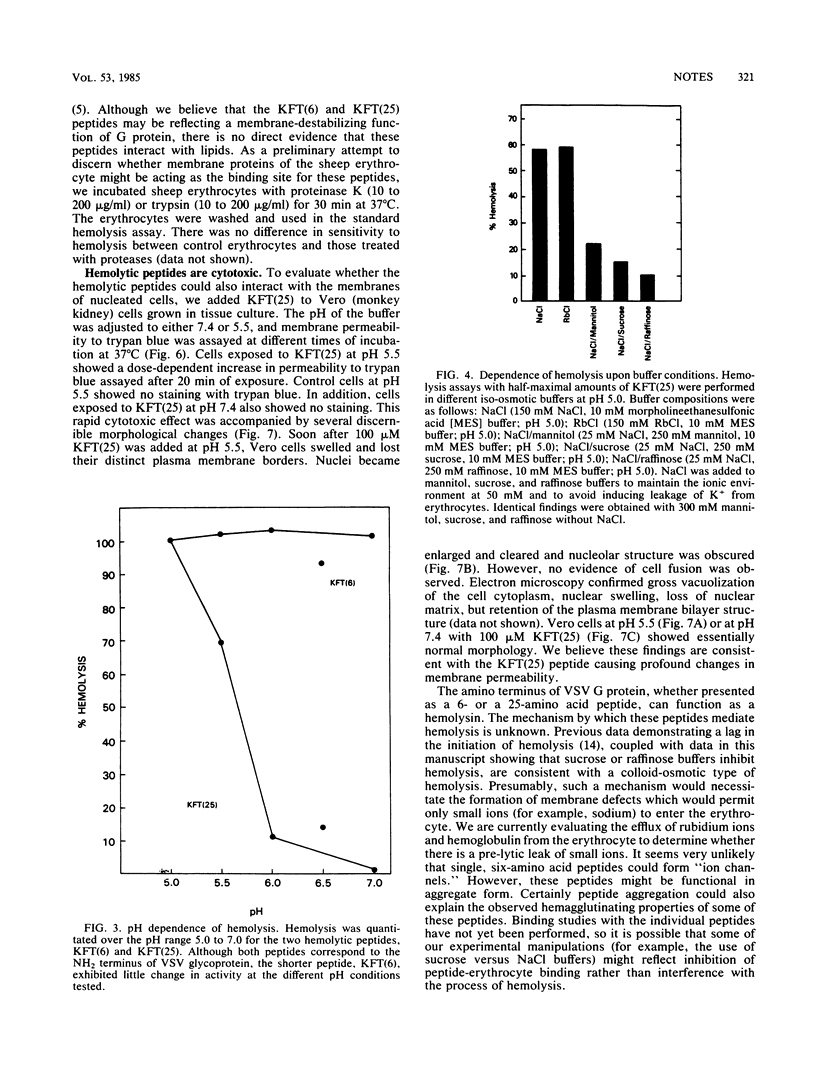
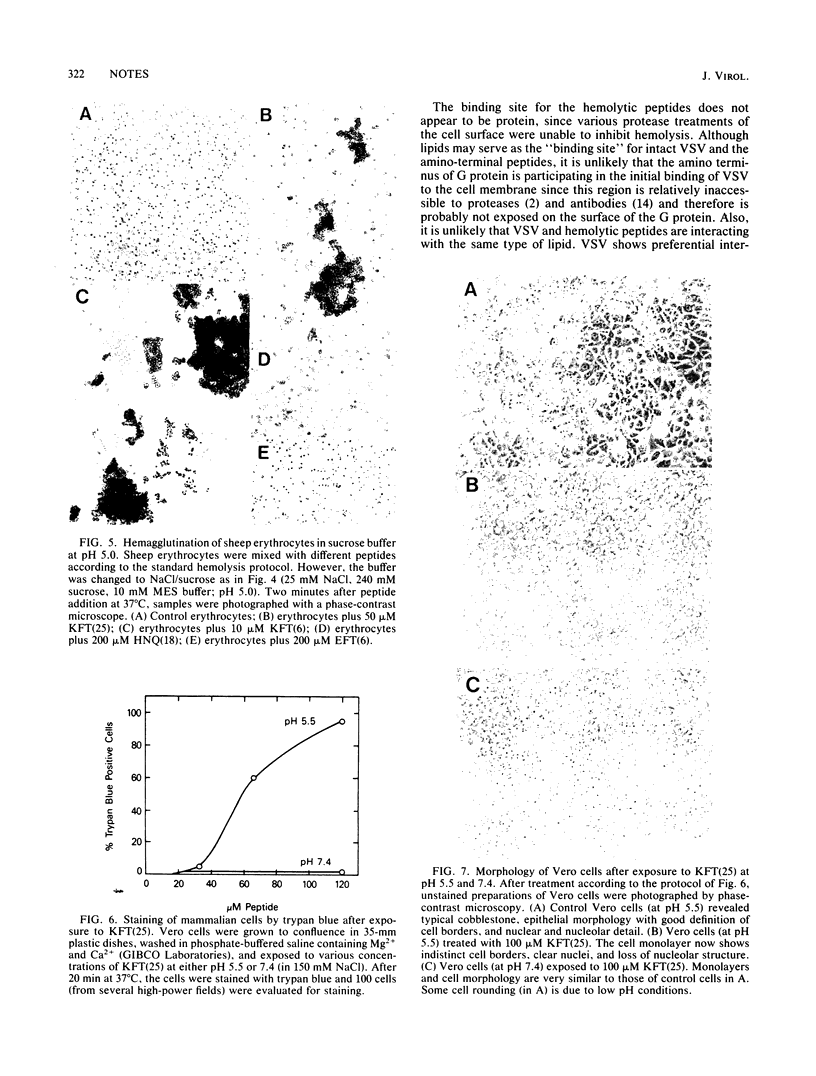
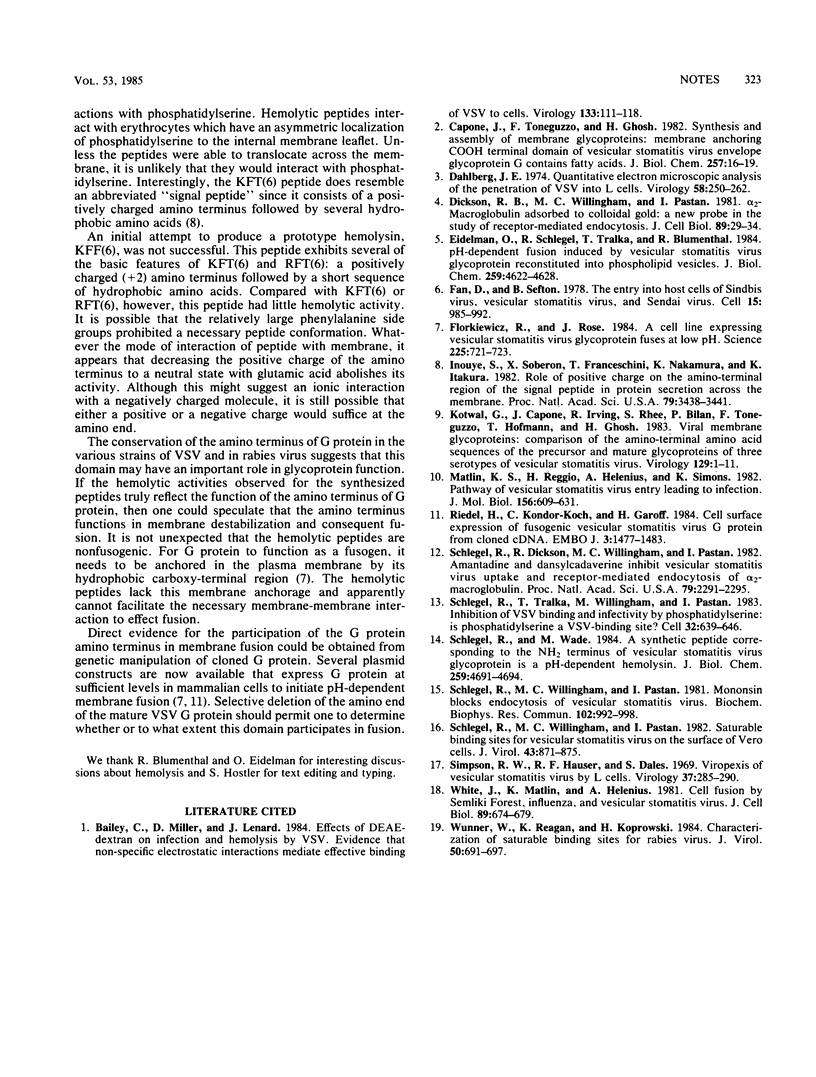
Images in this article
Selected References
These references are in PubMed. This may not be the complete list of references from this article.
- Bailey C. A., Miller D. K., Lenard J. Effects of DEAE-dextran on infection and hemolysis by VSV. Evidence that nonspecific electrostatic interactions mediate effective binding of VSV to cells. Virology. 1984 Feb;133(1):111–118. doi: 10.1016/0042-6822(84)90429-x. [DOI] [PubMed] [Google Scholar]
- Capone J., Toneguzzo F., Ghosh H. P. Synthesis and assembly of membrane glycoproteins. Membrane anchoring COOH-terminal domain of vesicular stomatitis virus envelope glycoprotein G contains fatty acids. J Biol Chem. 1982 Jan 10;257(1):16–19. [PubMed] [Google Scholar]
- Dahlberg J. E. Quantitative electron microscopic analysis of the penetration of VSV into L cells. Virology. 1974 Mar;58(1):250–262. doi: 10.1016/0042-6822(74)90159-7. [DOI] [PubMed] [Google Scholar]
- Dickson R. B., Willingham M. C., Pastan I. alpha 2-macroglobulin adsorbed to colloidal gold: a new probe in the study of receptor-mediated endocytosis. J Cell Biol. 1981 Apr;89(1):29–34. doi: 10.1083/jcb.89.1.29. [DOI] [PMC free article] [PubMed] [Google Scholar]
- Eidelman O., Schlegel R., Tralka T. S., Blumenthal R. pH-dependent fusion induced by vesicular stomatitis virus glycoprotein reconstituted into phospholipid vesicles. J Biol Chem. 1984 Apr 10;259(7):4622–4628. [PubMed] [Google Scholar]
- Fan D. P., Sefton B. M. The entry into host cells of Sindbis virus, vesicular stomatitis virus and Sendai virus. Cell. 1978 Nov;15(3):985–992. doi: 10.1016/0092-8674(78)90282-9. [DOI] [PubMed] [Google Scholar]
- Florkiewicz R. Z., Rose J. K. A cell line expressing vesicular stomatitis virus glycoprotein fuses at low pH. Science. 1984 Aug 17;225(4663):721–723. doi: 10.1126/science.6087454. [DOI] [PubMed] [Google Scholar]
- Inouye S., Soberon X., Franceschini T., Nakamura K., Itakura K., Inouye M. Role of positive charge on the amino-terminal region of the signal peptide in protein secretion across the membrane. Proc Natl Acad Sci U S A. 1982 Jun;79(11):3438–3441. doi: 10.1073/pnas.79.11.3438. [DOI] [PMC free article] [PubMed] [Google Scholar]
- Kotwal G. J., Capone J., Irving R. A., Rhee S. H., Bilan P., Toneguzzo F., Hofmann T., Ghosh H. P. Viral membrane glycoproteins: comparison of the amino terminal amino acid sequences of the precursor and mature glycoproteins of three serotypes of vesicular stomatitis virus. Virology. 1983 Aug;129(1):1–11. doi: 10.1016/0042-6822(83)90390-2. [DOI] [PubMed] [Google Scholar]
- Matlin K. S., Reggio H., Helenius A., Simons K. Pathway of vesicular stomatitis virus entry leading to infection. J Mol Biol. 1982 Apr 15;156(3):609–631. doi: 10.1016/0022-2836(82)90269-8. [DOI] [PubMed] [Google Scholar]
- Riedel H., Kondor-Koch C., Garoff H. Cell surface expression of fusogenic vesicular stomatitis virus G protein from cloned cDNA. EMBO J. 1984 Jul;3(7):1477–1483. doi: 10.1002/j.1460-2075.1984.tb01999.x. [DOI] [PMC free article] [PubMed] [Google Scholar]
- Schlegel R., Dickson R. B., Willingham M. C., Pastan I. H. Amantadine and dansylcadaverine inhibit vesicular stomatitis virus uptake and receptor-mediated endocytosis of alpha 2-macroglobulin. Proc Natl Acad Sci U S A. 1982 Apr;79(7):2291–2295. doi: 10.1073/pnas.79.7.2291. [DOI] [PMC free article] [PubMed] [Google Scholar]
- Schlegel R., Tralka T. S., Willingham M. C., Pastan I. Inhibition of VSV binding and infectivity by phosphatidylserine: is phosphatidylserine a VSV-binding site? Cell. 1983 Feb;32(2):639–646. doi: 10.1016/0092-8674(83)90483-x. [DOI] [PubMed] [Google Scholar]
- Schlegel R., Wade M. A synthetic peptide corresponding to the NH2 terminus of vesicular stomatitis virus glycoprotein is a pH-dependent hemolysin. J Biol Chem. 1984 Apr 25;259(8):4691–4694. [PubMed] [Google Scholar]
- Schlegel R., Willingham M. C., Pastan I. H. Saturable binding sites for vesicular stomatitis virus on the surface of Vero cells. J Virol. 1982 Sep;43(3):871–875. doi: 10.1128/jvi.43.3.871-875.1982. [DOI] [PMC free article] [PubMed] [Google Scholar]
- Schlegel R., Willingham M., Pastan I. Monensin blocks endocytosis of vesicular stomatitis virus. Biochem Biophys Res Commun. 1981 Oct 15;102(3):992–998. doi: 10.1016/0006-291x(81)91636-3. [DOI] [PubMed] [Google Scholar]
- Simpson R. W., Hauser R. E., Dales S. Viropexis of vesicular stomatitis virus by L cells. Virology. 1969 Feb;37(2):285–290. doi: 10.1016/0042-6822(69)90209-8. [DOI] [PubMed] [Google Scholar]
- White J., Matlin K., Helenius A. Cell fusion by Semliki Forest, influenza, and vesicular stomatitis viruses. J Cell Biol. 1981 Jun;89(3):674–679. doi: 10.1083/jcb.89.3.674. [DOI] [PMC free article] [PubMed] [Google Scholar]
- Wunner W. H., Reagan K. J., Koprowski H. Characterization of saturable binding sites for rabies virus. J Virol. 1984 Jun;50(3):691–697. doi: 10.1128/jvi.50.3.691-697.1984. [DOI] [PMC free article] [PubMed] [Google Scholar]



